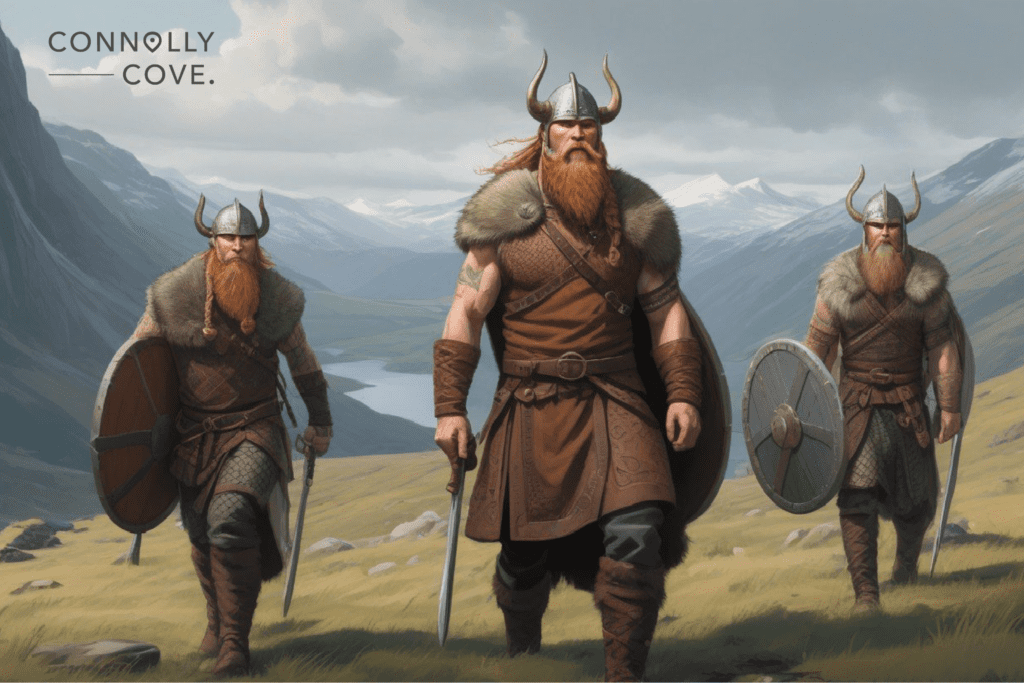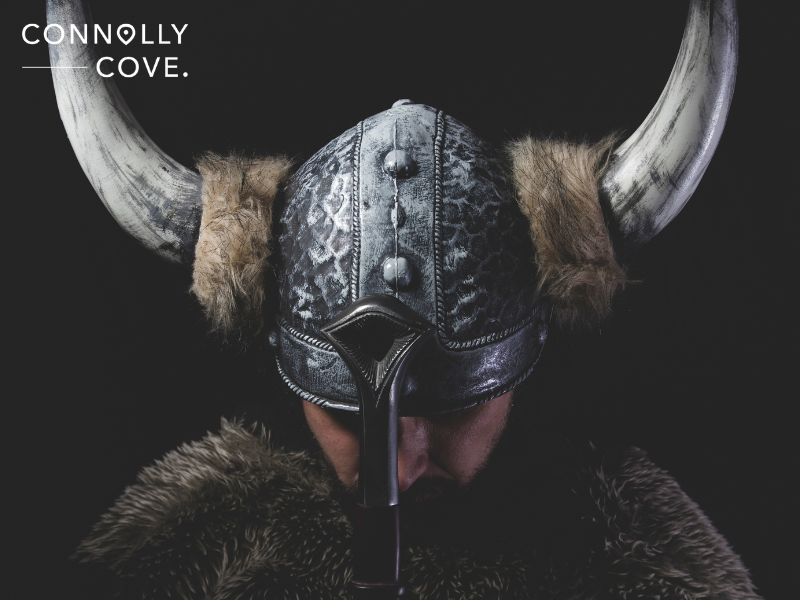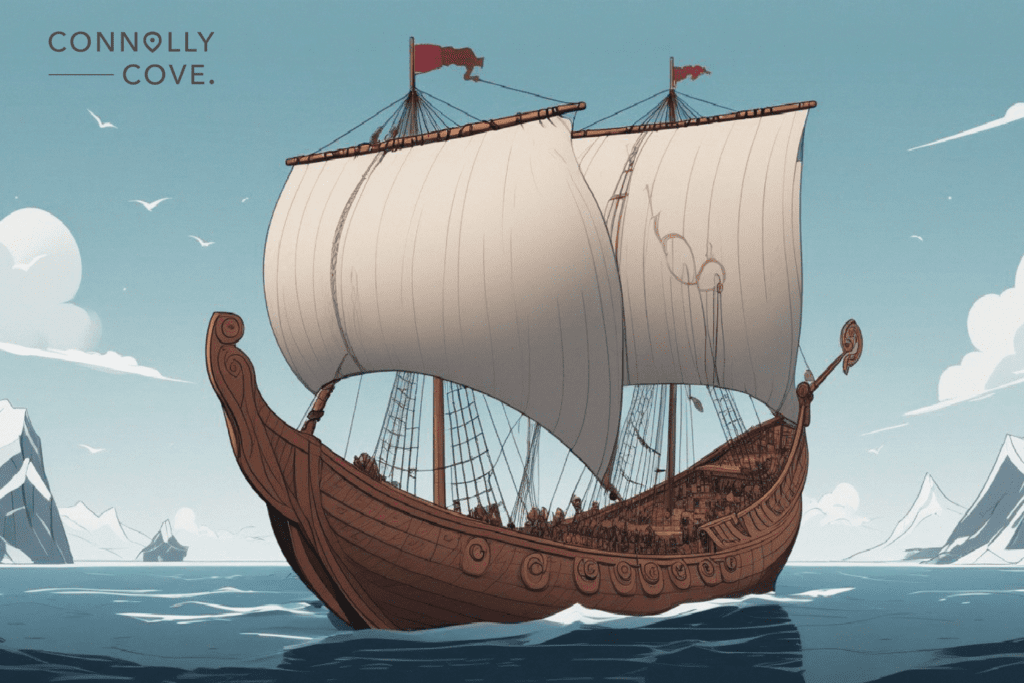Uncovering the Impact of Irish Vikings on Ireland’s History

Updated On: April 23, 2024 by Maha Yassin
Do you reckon the Vikings were nothing more than plundering brutes in Ireland, or is there a snippet of curiosity within you that suspects they might’ve left something meaningful behind? We admit we held similar views until quite recently.
Unearthed archaeological treasures and fresh historical studies have highlighted an intriguing facet of our past —these Scandinavian nomads weren’t just fierce warriors and significant architects of Irish society and culture.
They gave us bustling towns, brought over ground-breaking technologies and even stirred up the mixture in our genetic potpourri! Are you intrigued about how these Norse settlers sculpted Medieval Ireland? Come now, let’s set off together on this jolly good journey through the meandering lanes of history!
Table of Contents
The Viking Age in Ireland: A Saga of Raids, Trade, and Transformation
The Emerald Isle, renowned for its rolling green hills and ancient mystique, holds within its history a chapter marked by the arrival of formidable seafarers from the north. The Viking Age in Ireland, spanning roughly from 795 to 1050 AD, was a period of profound change, leaving an indelible mark on the island nation’s culture, language, and urban development.
From Fearsome Raiders to Savvy Traders
The early years of the Viking Age were etched with fear. Horned helmets glinted in the Irish sun as sleek and swift longships sliced through the emerald waters. Monasteries, symbols of purity and wealth, became prime targets for these raiders, eager for plunder and slaves. The Irish annals, chronicles meticulously kept by monks, are filled with chilling accounts of these attacks, like the 795 AD raid on Rathlin Island, where the monastery was desecrated and its inhabitants killed.
But over time, the tide began to turn. The shrewd and adaptable Vikings recognised Ireland’s potential beyond mere plunder. They established more permanent settlements, strategically choosing sheltered harbours and navigable rivers. Dublin, Waterford, Limerick, and Cork all bear the legacy of these Norse explorers, transforming from fledgling outposts into bustling centres of trade and commerce.
A Tapestry of Cultural Exchange

As Vikings and Irish interacted, their cultures began to weave together like threads in a rich tapestry. Norse words, like “scalp” and “ganger,” found their way into the Irish language, enriching its vocabulary. Viking artistic styles, characterised by intricate knotwork and stylised animal figures, influenced Irish aesthetics, adding a new layer of visual complexity. Even Irish epic tales, steeped in myth and legend, may have drawn inspiration from Viking sagas, blurring the lines between folklore and reality.
The Vikings weren’t merely plunderers and traders but also urban pioneers. Their settlements laid the groundwork for Ireland’s first real cities, complete with fortified defences, bustling торговые markets, and ремесленнические workshops. This introduction of an urban lifestyle, with its distinct social and economic structures, marked a turning point in Irish history.
Shifting Sands of Power
The arrival of the Vikings irrevocably altered the political landscape of Ireland. They carved out kingdoms for themselves, the most notable being the Kingdom of Dublin, often entangled in a complex web of alliances and rivalries with existing Irish kingdoms. This dynamic interplay of power added a layer of intrigue to Irish politics, shaping history for centuries to come.
Viking Echoes in the Emerald Isle
The legacy of the Irish Vikings continues to resonate throughout Ireland. Place names along the coast whisper of their presence, like Wexford (“Weir of the Fords”) and Wicklow (“Long Meadow”). Recent genetic studies suggest that up to 20% of the Irish population carries Viking ancestry, a testament to the deep integration of the two cultures.
From archaeological sites teeming with artefacts to captivating sagas passed down through generations, the Viking Age in Ireland remains a source of fascination and exploration. It is a period etched in conflict and cultural exchange, a reminder of the transformative power of interaction and the enduring mark that even the most fearsome raiders can leave on a land they eventually call home.
So, the next time you raise a pint of Guinness in a bustling Dublin pub or gaze upon the ancient walls of Waterford, remember the saga of the Irish Vikings. Their story is one of courage, adaptation, and a remarkable fusion of cultures that continues to shape the Emerald Isle.
Famous Irish Vikings and Their Stories
The Irish Vikings’ stories are as diverse as the rugged coastlines they navigated. From the ruthless Ivar the Boneless, who carved a kingdom with the edge of his axe, to the enigmatic Sitric Silkbeard, a king who straddled the line between Norse and Gael, each Viking’s saga adds a unique thread to the rich tapestry of Irish history.
Let’s delve into the lives and legends of these fascinating figures. We’ll meet kings and queens, warriors and saints, all leaving their mark on a land that will forever bear the scars of their presence.

Ivar the Boneless
Arguably the most notorious Irish Viking in history, Ivar “the Boneless” (also known as Ívarr hinn Beinlausi) commanded the “Great Heathen Army” that ravaged Britain and Ireland in the 9th century. Despite the nickname’s ambiguity, Ivar proved a cunning and ruthless leader. He established the Viking Kingdom of Dublin and raided monasteries, leaving a trail of fear and destruction. His legacy remains controversial, a mix of brutality and political acumen.
Olaf the White
Ivar’s brother, Olaf the White (Óláfr hvíta), co-ruled Dublin with Ivar and participated in many of their conquests. He led raids throughout Ireland and England, acquiring a reputation for bravery and cruelty. Though overshadowed by Ivar, Olaf played a crucial role in establishing Viking power in Ireland.
Sitric Silkbeard
Born to a Viking father and an Irish mother, Sitric Silkbeard (Sigtryggr Silki Skeggi) straddled both worlds. He became King of Dublin, marrying King Mael Sechnaill’s daughter and converting to Christianity. Sitric ruled Dublin for over 20 years, bringing relative peace and prosperity. He even fought alongside Irish kings against other Vikings, showcasing his complex identity and the evolving relationship between Vikings and the Irish.
Gormflaith
Queen Gormflaith (Gormflaith ingen Murchada) is an influential and controversial figure. Married to Brian Boru, High King of Ireland, she allied with the Vikings against him, contributing to the Battle of Clontarf in 1014. Though this pivotal battle ended in Brian’s death, it marked a turning point in Viking dominance in Ireland. Gormflaith’s ambition and political manoeuvring cemented her as a complex and fascinating character in Irish history.
Turgesius
Notorious for his cruelty, Turgesius (Thorgils) terrorised Ireland in the early 9th century. He seized Dublin and enslaved numerous Irish, even crucifying the Archbishop of Armagh. However, his reign of terror was short-lived. Captured by Máel Sechnaill, he was drowned in Lough Owel, becoming a symbol of Irish resistance against Viking aggression.
Exploring the stories of these famous Irish Vikings offers a glimpse into the complex web of conflict, trade, and cultural exchange that characterised the Viking Age in Ireland. Remember, many other fascinating figures contributed to this period, including:
- Ragnar Lodbrok : The father of Ivar and Olaf Lodbrok.
- Maríu Ólafsson: A Viking prince converted to Christianity and became Bishop of Dublin.
- Harald Blacktooth: A Danish king who battled the Irish and other Irish Vikings to control Dublin.
Understanding these individuals and their stories sheds light on the rich tapestry of the Viking Age in Ireland, a period that forever changed the island’s history and cultural landscape.
Irish Viking Attractions to Visit in Ireland
The Irish Vikings had a lasting impact on Ireland and left behind a lot of history to learn. Choosing the perfect Viking attraction in Ireland depends on your interests and travel style! Here are some exciting options, each catering to different preferences while adhering to safety and ethical guidelines:
For the History Buffs
- Dublinia: Immerse yourself in Viking Dublin at this interactive museum. Explore reconstructed streets, witness archaeological finds, and even try your hand at Viking crafts like weaving and wood carving.
- National Museum of Ireland: Delve into the Viking Age through artefacts like weapons, jewellery, and everyday objects. Learn about their trade networks, artistic styles, and daily lives.
- Clonmacnoise: This ancient monastic settlement, once raided by Vikings, offers a glimpse into early Irish life and the impact of Irish Viking raids. Explore ruins of churches, towers, and high crosses, and soak in the historical atmosphere.
For the Adventure Seekers
- Viking Ship Tour: Sail the Dublin Bay on a replica Viking ship and experience the thrill of navigating like these intrepid seafarers. Learn about sailing techniques, hear Viking tales, and enjoy the scenic views.
- Loughcrew Cairns: Hike to these ancient burial mounds in County Meath, which are rumoured to have been used by Irish Vikings as lookout points. Explore the chambers and passageways, and imagine the stories these hills hold.
- Hook Head Lighthouse: Enjoy panoramic coastal views and learn about the area’s rich maritime history.
For the Families
- Kells Bay House & Gardens: This Viking-era manor house near Kells offers interactive exhibits, storytelling sessions, and even Viking reenactments. Kids can dress up, try their hand at crafts, and learn about daily Viking life in a fun and engaging way.
- Jeanie Johnston Ship: Explore this replica famine ship in Dublin, which was used to transport Irish emigrants during the Potato Famine. Learn about the historical context and the possible Viking influence on shipbuilding techniques.
- The Viking World: This interactive exhibition at the Ulster Museum in Belfast brings the Viking Age to life through multimedia displays, reconstructions, and hands-on activities. Kids can explore a Viking village, learn about Norse mythology, and even play Viking games.
These are just a few suggestions, and many other fantastic Viking attractions await in Ireland. Remember to research opening hours, ticket prices, and accessibility before your visit. No matter your interests, a Viking adventure awaits you in the Emerald Isle!

The Vikings Beyond Ireland
While the whispers of Viking raids may first conjure images of the Emerald Isle, their story unfolds across a far grander stage. These daring seafarers, driven by an insatiable wanderlust and a thirst for adventure, carved their names on the map of Europe in a saga far exceeding mere Irish shores.
In the East, along the Dnieper, their axes and trade goods birthed the mighty Kievan Rus’, and their swords found honour as Varangian guards within the gilded halls of Constantinople. Westward, the Danelaw in England stands as a testament to their martial prowess, while the legacy of their settlements resonates in the very name of Normandy. This region would change the course of English history. Even the icy wilderness of Iceland and Greenland couldn’t quench their thirst for exploration, with their sagas echoing across centuries, reminding us of their audacious pioneering spirit.
So, the next time you hear whispers of the Vikings, remember theirs is not a tale confined to misty Irish shores. It is a saga etched across Europe, a testament to the boundless ambitions and enduring legacy of a people who dared to push the boundaries of the known world.
They were not just raiders but traders, builders, and storytellers, forever leaving their mark on the continent’s rich tapestry of history and culture. So, let us venture beyond the Emerald Isle and lose ourselves in the epic chronicles of the Irish Vikings, their exploits reminding us that even the most uncharted waters can hold untold stories waiting to be discovered.
In conclusion, the Irish Vikings profoundly impacted Ireland’s history. They established significant towns and trading centres, introduced new technologies, and left a genetic imprint on the Irish population. Their influence can still be seen in modern-day perceptions of the Irish Viking Age.
FAQs
What was the impact of the Viking invasion on Ireland?
The Viking invasion led to a period of raids and defeat at Gaelic Irish coastal settlements but also brought Scandinavian influences into Irish culture.
Who were the biggest invaders in Medieval Ireland?
The Vikings from Scandinavian countries had an intensive raiding period in Medieval Ireland, notably shaking up quiet Irish monasteries.
Where did Vikings set up their homes when they came to Ireland?
Vikings built Norse settlements called Dubhlinn and Vadrefjord after invading Ireland, which are key cities now known as Dublin and Waterford.
Did the presence of Viking warriors alter the ways of life for those living in medieval Ireland?
While Viking warriors initially struck fear with violent raids, their long stay resulted in a mix of cultures that greatly impacted how people lived on this island during medieval times.






